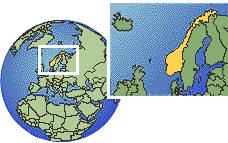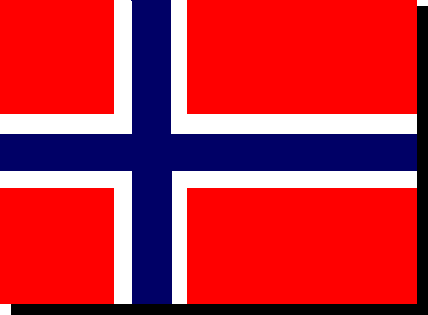Norway
History
 Location:
Northern Europe, bordering the North Sea and the North Atlantic
Ocean, west of Sweden Location:
Northern Europe, bordering the North Sea and the North Atlantic
Ocean, west of Sweden
Geographic coordinates: 62 00 N, 10 00 E
 Map
references: Europe Map
references: Europe
Area:
total: 324,220 sq km
land: 307,860 sq km
water: 16,360 sq km
Area - comparative: slightly larger than New Mexico
Land boundaries:
total: 2,515 km
border countries: Finland 729 km, Sweden 1,619 km, Russia 167 km
Coastline: 21,925 km (includes mainland 3,419 km, large islands
2,413 km, long fjords, numerous small islands, and minor
indentations 16,093 km)
Maritime claims:
contiguous zone: 10 nm
continental shelf: 200 nm
exclusive economic zone: 200 nm
territorial sea: 4 nm
Climate: temperate along coast, modified by North Atlantic
Current; colder interior; rainy year-round on west coast
Terrain: glaciated; mostly high plateaus and rugged mountains
broken by fertile valleys; small, scattered plains; coastline
deeply indented by fjords; arctic tundra in north
Elevation extremes:
lowest point: Norwegian Sea 0 m
highest point: Galdhopiggeh 2,469 m
Natural resources: petroleum, copper, natural gas, pyrites,
nickel, iron ore, zinc, lead, fish, timber, hydropower
Land use:
arable land: 3%
permanent crops: 0%
permanent pastures: 0%
forests and woodland: 27%
other: 70% (1993 est.)
Irrigated land: 970 sq km (1993 est.)
Natural hazards: NA
Environment - current issues: water pollution; acid rain
damaging forests and adversely affecting lakes, threatening fish
stocks; air pollution from vehicle emissions
Environment - international agreements:
party to: Air Pollution, Air Pollution-Nitrogen Oxides, Air
Pollution-Persistent Organic Pollutants, Air Pollution-Sulphur
85, Air Pollution-Sulphur 94, Air Pollution-Volatile Organic
Compounds, Antarctic-Environmental Protocol, Antarctic Treaty,
Biodiversity, Climate Change, Desertification, Endangered
Species, Environmental Modification, Hazardous Wastes, Law of
the Sea, Marine Dumping, Nuclear Test Ban, Ozone Layer
Protection, Ship Pollution, Tropical Timber 83, Tropical Timber
94, Wetlands, Whaling
signed, but not ratified: Climate Change-Kyoto Protocol
Geography - note: about two-thirds mountains; some 50,000
islands off its much indented coastline; strategic location
adjacent to sea lanes and air routes in North Atlantic; one of
most rugged and longest coastlines in world; Norway is the only
NATO member having a land boundary with Russia
Background: Despite its neutrality, Norway was not able to avoid
occupation by Germany in World War II. In 1949, neutrality was
abandoned and Norway became a member of NATO. Discovery of oil
and gas in adjacent waters in the late 1960s boosted Norway's
economic fortunes. The current focus is on containing spending
on the extensive welfare system and planning for the time when
petroleum reserves are depleted. In referenda held in 1972 and
1994, Norway rejected joining the EU.
People
Population: 4,481,162 (July 2000 est.)
Age structure:
0-14 years: 20% (male 459,608; female 434,809)
15-64 years: 65% (male 1,472,974; female 1,430,526)
65 years and over: 15% (male 283,741; female 399,504) (2000
est.)
Population growth rate: 0.5% (2000 est.)
Birth rate: 12.79 births/1,000 population (2000 est.)
Death rate: 9.89 deaths/1,000 population (2000 est.)
Net migration rate: 2.13 migrant(s)/1,000 population (2000 est.)
Sex ratio:
at birth: 1.06 male(s)/female
under 15 years: 1.06 male(s)/female
15-64 years: 1.03 male(s)/female
65 years and over: 0.71 male(s)/female
total population: 0.98 male(s)/female (2000 est.)
Infant mortality rate: 3.98 deaths/1,000 live births (2000 est.)
Life expectancy at birth:
total population: 78.65 years
male: 75.73 years
female: 81.77 years (2000 est.)
Total fertility rate: 1.81 children born/woman (2000 est.)
Nationality:
noun: Norwegian(s)
adjective: Norwegian
Ethnic groups: Norwegian (Nordic, Alpine, Baltic), Lapps (Sami)
20,000
Religions: Evangelical Lutheran 86% (state church), other
Protestant and Roman Catholic 3%, other 1%, none and unknown 10%
(1997)
Languages: Norwegian (official)
note: small Lapp- and Finnish-speaking minorities
Literacy:
definition: age 15 and over can read and write
total population: 100%
male: NA%
female: NA%
Communications
Telephones - main lines in use: 2,325,010 (1997)
Telephones - mobile cellular: 1,676,763 (1997)
Telephone system: high-quality domestic and international
telephone, telegraph, and telex services
domestic: domestic satellite system
international: 2 buried coaxial cable systems; 4 coaxial
submarine cables; satellite earth stations - NA Eutelsat, NA
Intelsat (Atlantic Ocean), and 1 Inmarsat (Atlantic and Indian
Ocean regions); note - Norway shares the Inmarsat earth station
with the other Nordic countries (Denmark, Finland, Iceland, and
Sweden)
Radio broadcast stations: AM 5, FM at least 650, shortwave 1
(1998)
Radios: 4.03 million (1997)
Television broadcast stations: 209 (1997)
Televisions: 2.03 million (1997)
Internet Service Providers (ISPs): 21 (1999)
Transportation
Railways:
total: 4,012 km
standard gauge: 4,012 km 1.435-m gauge (2,530 km electrified; 96
km double track) (1998)
Highways:
total: 90,741 km
paved: 67,602 km (including 128 km of expressways)
unpaved: 23,139 km (1998 est.)
Waterways: 1,577 km along west coast; navigable by 2.4 m draft
vessels maximum
Pipelines: refined petroleum products 53 km
Ports and harbors: Bergen, Drammen, Floro, Hammerfest, Harstad,
Haugesund, Kristiansand, Larvik, Narvik, Oslo, Porsgrunn,
Stavanger, Tromso, Trondheim
Merchant marine:
total: 788 ships (1,000 GRT or over) totaling 21,460,260 GRT/34,178,125
DWT
ships by type: bulk 100, cargo 142, chemical tanker 111,
combination bulk 9, combination ore/oil 35, container 18,
liquified gas 86, multi-functional large load carrier 1,
passenger 11, petroleum tanker 157, refrigerated cargo 11,
roll-on/roll-off 48, short-sea passenger 22, vehicle carrier 37
(1999 est.)
note: the government has created an internal register, the
Norwegian International Ship register (NIS), as a subset of the
Norwegian register; ships on the NIS enjoy many benefits of
flags of convenience and do not have to be crewed by Norwegians
(1998 est.)
Airports: 103 (1999 est.)
Airports - with paved runways:
total: 67
over 3,047 m: 1
2,438 to 3,047 m: 12
1,524 to 2,437 m: 13
914 to 1,523 m: 12
under 914 m: 29 (1999 est.)
Airports - with unpaved runways:
total: 36
914 to 1,523 m: 5
under 914 m: 31 (1999 est.)
Heliports: 1 (1999 est.)
|